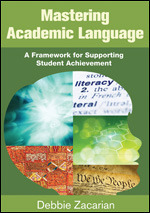Mastering Academic Language
no information available
A legacy of the No Child Left Behind legislation of 2001 is that the significant achievement gaps between language minority students (ELLs and other speakers of non-Standard English) were made painfully visible to educators and the general public. Unfortunately, disaggregating data or 'exposing the cracks beneath the wallpaper' (Johnson/Avelar La Salle, 2010) alone is an insufficient remedy. Addressing these gaps remains a salient theme of our nation's school reform agenda and will be for years to come. Over the years, Corwin has published a number of works that aim to help close achievement gaps between ELs and non-ELs as well as children of color and their White counterparts. Some of these titles are aimed at school leaders and suggest that a 'top down' approach emphasizing culture shifts and policy changes are the most effective starting points. (see, e.g., Lindsey et al., Cultural Proficiency: A Manual for School Leaders, Singleton, Courageous Conversations about Race, and the upcoming Walking the Equity Walk by John Browne. Other titles start with changing practices at the classroom level, e.g., Bonnie Davis' How to Teach Students Who Don't Look Like You. The proposed title which falls into this second category highlights the importance of mastering Academic Language as a key to school success and closing achievement. It is grounded in an originaláfour-pronged framework that describes how academic language learning is a (1) sociocultural, (2) literacy learning, (3) academic, and (4) a cognitive (higher order thinking skill) process.á Written in a teacher-friendly voice, the book emphasizes what can be done to strategically plan and deliver high quality learning, school and parent engagement environments using this four pronged framework. It is also well-suited to the work of teacher teams and includes a number of reflective prompts and professional development activities. ... Read more Read less











